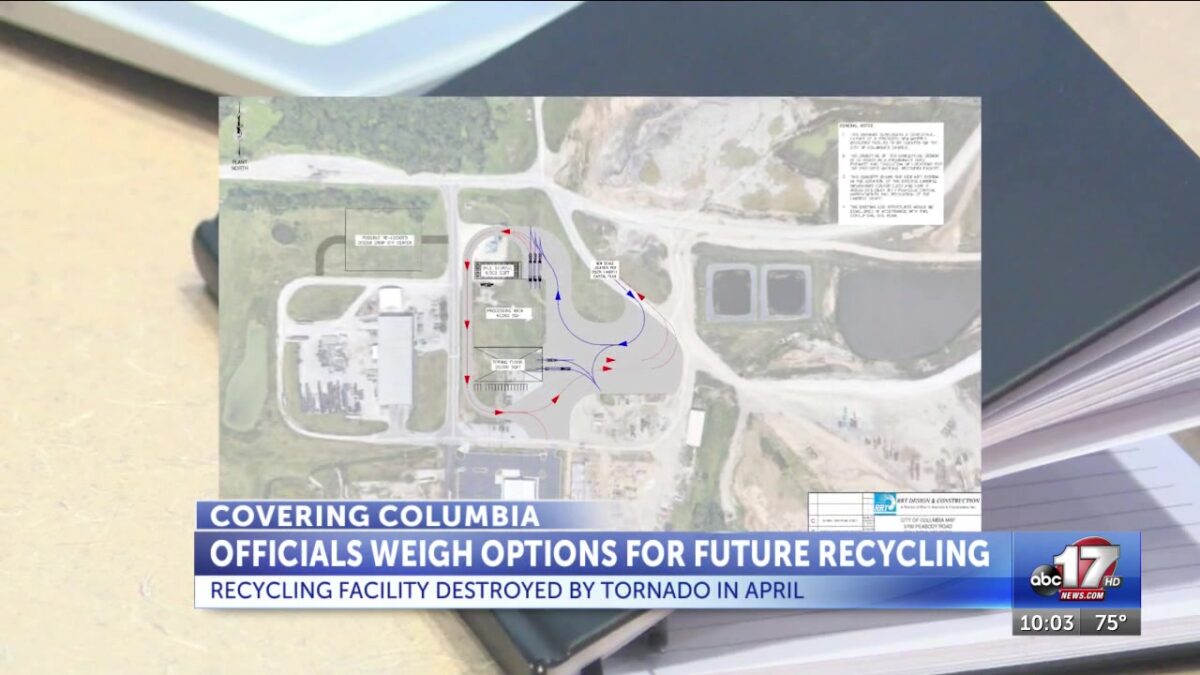Columbia officials weigh options for recycling after tornado damage to facility

Mitchell Kaminski
EDITOR’S NOTE: The Columbia City Council ward representated by Don Waterman has been corrected.
COLUMBIA, Mo. (KMIZ)
The City of Columbia council members discussed the future of recycling on Monday, during its pre-council meeting.
The meeting comes after the city’s Material Recovery Facility was destroyed by an April 20th tornado.
According to a presentation shown to the council, the estimated cost to rebuild a new facility will be between $ 26.47 million to $26.71 million and take 30 months to build a permanent structure.
The three options discussed Monday include building a new MRF facility on the current site and saving as much of the existing structure as possible. Under this option, the city would save over $500,000 on demolition costs due to the storm, however, not much of the facility can be salvaged.
The second option involves constructing a new MRF at the current Landfill Operations Center site, while the final option proposes building a new facility on the open gravel lot west of the Administration building.
Option B would have preserved the existing MRF building for future use, but due to the damage from the tornado, that is no longer possible. It also presents stormwater challenges and would require relocating parking. The final option offers the largest footprint but raises traffic concerns and eliminates laydown and storage areas.
The city is also weighing no longer processing recyclables in Columbia instead of building a new MRF.
According to city staff, Columbia initially dismissed this option because of “unacceptable financial and climate impacts” of transferring materials to St. Louis. However, with the MRF destroyed, the city will consider transferring its materials to Jefferson City.
Another potential option the city is considering is to build a multi-material environmental center that would serve as a “one-stop shop” to handle multiple recycling materials and hazardous waste. The council was shown several examples of centers in Olmstead County, Minnesota, Tampa, Florida, and Charlottesville, Virginia.
“I’ve made the comment publicly that I think this is an opportunity, if we’re going to continue to recycle and based on the responses I got, there’s certainly a desire for Colombians to continue recycling, that maybe we should look at overhauling the process,” Ward 5 Councilman Don Waterman said. “ The biggest one there would be the automated collection.”
Even before the tornado, Columbia had been exploring options to update its MRF.
A recent evaluation of Columbia’s recycling and waste diversion program conducted in September of 2024 revealed critical challenges, including suspended curbside recycling collection, contamination at drop-off centers, and inefficiencies at the MRF. The report, prepared by RRT Design & Construction, emphasized the need to prioritize resuming curbside collection—even on a biweekly basis—to stabilize recycling operations.
“The majority of this report was drafted before the tornado,” Waterman said. “There’s a couple of footnotes to that effect about possibly relocating it within or around the landfill. Now, we’ve got that spot as well, so that we could just start fresh and go on from there.”
Key issues include contaminated loads from drop-off centers, aging and underperforming MRF equipment, and safety concerns. The study recommends reallocating resources to curbside collection by consolidating and closing poorly performing drop-off sites and reducing or temporarily halting MRF operations.
“There’s a couple of sites, especially around campus, that there were a lot of issues with contamination because people they weren’t just dropping off recycling, we’ll put it that way,” Waterman said.
The evaluation also recommended discontinuing curbside glass collection, adopting single-cart recycling collection, optimizing routes with software, and staffing improvements.In an updated report, RRT recommended constructing a new MRF at the current Landfill Operations Center (option B). RRT concluded that the site meets the needs for the new facility, offers safer traffic flow, and fits with planned capital improvements. It also avoids complications with temporary processing and the loss of space for other projects.